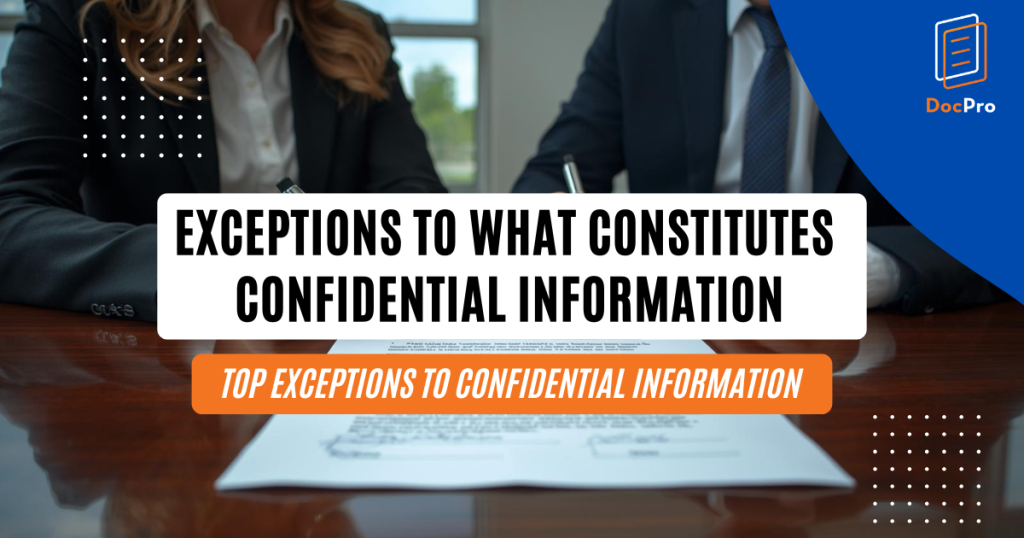Exceptions to What Constitutes Confidential Information
24 Oct 2025
24 Oct 2025
min read

When drafting or signing an NDA, not all information qualifies as “confidential,” and understanding the exceptions to what constitutes confidential information is crucial for drafting effective contracts and protecting your interests. Whether you're an entrepreneur, legal professional, or corporate executive, knowing the boundaries of confidentiality can help you avoid legal pitfalls and ensure your agreements are enforceable. In this guide, we will explore the key exceptions to confidentiality, provide practical examples, and show you how to safeguard your data using our professionally drafted legal templates.
What is Confidential Information?
Confidential information refers to any data or knowledge that is not publicly known and is shared in a context where secrecy is expected. This may include:
-
Trade secrets
-
Business plans
-
Financial records
-
Customer lists
-
Proprietary technology
-
Legal strategies
In most cases, this information is protected through non-disclosure agreements (NDAs) or confidentiality clauses in broader contracts. However, not all information is protected equally, and certain exceptions apply.
Click to read more about “How to Define Confidential Information?”
Or find out the difference between Privacy vs. Confidentiality.
Why Exceptions Matter
Understanding the exceptions to confidentiality is essential for several reasons:
-
✅ It helps you avoid overreaching in your contracts.
-
✅ It ensures enforceability in court.
-
✅ It protects parties from unjust liability.
-
✅ It clarifies the scope of protection for both discloser and recipient.
Failing to account for these exceptions can render your confidentiality clauses unenforceable or lead to unintended disclosures.
Top Exceptions to Confidential Information
Below are the most common and legally recognized exceptions to what constitutes confidential information:
1. Publicly Available Information
Information that is already in the public domain is not considered confidential. This includes:
-
Data published in newspapers, journals, or websites
-
Information disclosed in public records
-
Content shared in press releases or public filings
📌 Example: If a company’s financials are published in its annual report, they cannot be considered confidential.
2. Independently Developed Information
If the recipient of the information can prove that they developed the knowledge independently, without access to the confidential data, it is not protected.
Examples include:
-
A software developer creating similar code without referencing the original
-
A marketing strategy developed through independent research
3. Information Already Known to the Recipient
If the recipient already had access to the information before it was disclosed under a confidentiality agreement, it is not considered confidential.
How to Prove Prior Knowledge:
-
Email correspondence
-
Internal memos
-
Dated documents
4. Information Disclosed Under Legal Obligation
If a court, government agency, or regulatory body requires disclosure, the information is no longer protected under confidentiality.
Examples:
-
Court subpoenas
-
Regulatory audits
-
Law enforcement investigations
📌 Pro Tip: Include a clause in your NDA that requires the recipient to notify you when disclosing under legal obligation.
5. Consent-Based Disclosure
If the disclosing party gives written consent for the information to be shared, it is no longer confidential.
Best Practices:
-
Always require written consent
-
Specify the scope and duration of the consent
-
Keep records of all consents granted
📌 Example: A startup may allow a potential investor to share confidential data with legal advisors.
Use Legal Templates to Ensure Compliance
Understanding the exceptions to what constitutes confidential information is essential for anyone dealing with sensitive data. By recognizing what falls outside the scope of confidentiality, you can draft more effective agreements, avoid legal disputes, and protect your business interests.
✅ Ready to Protect Your Information?
-
📄 Download a Confidentiality Agreement
-
🔐 Customize your NDA Template
-
🧾 Explore DocPro’s Full Legal Library
Your data is valuable. Protect it with the power of professional legal documentation.
Read more about NDAs: